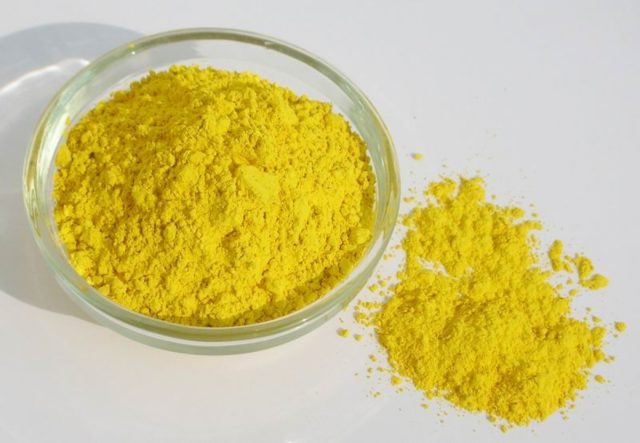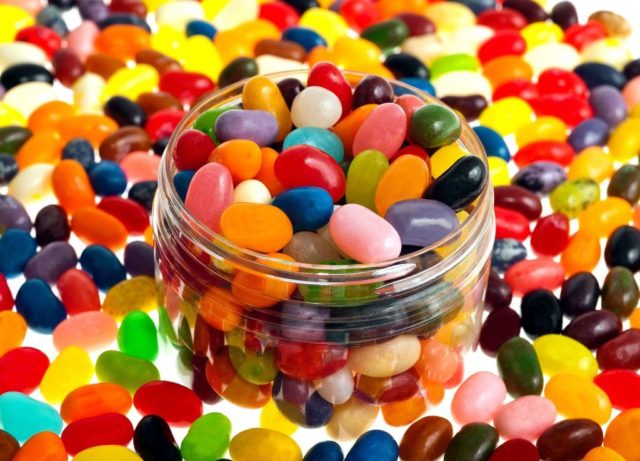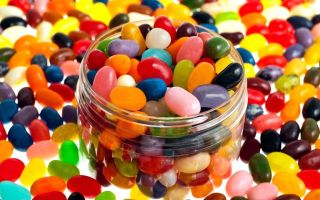Content
The synthetic dye tartrazine E102 imparts yellow color to products. This is one of the cheapest dyes, its price does not exceed 600 rubles. for 1 kg. Despite the fact that the additive is considered potentially dangerous, it is actively used in the food industry.
What is tartrazine
Substance E102 is a synthetic colorant. It is absent in the natural environment. In physical form, tartrazine is a powder that dissolves in water. It is yellow in color with a golden tint. E102 can look like powder, granulate or aqueous solution.
Tartrazine is intended to increase the attractiveness of food products. It gives them a pleasant lemon-yellow hue. This is how manufacturers are trying to influence ordinary consumers. Outwardly attractive products are subconsciously perceived by people as natural.
The chemical formula of tartrazine looks like this: C16H9N4Na3O9S2.
Tartrazine is approved for use in food production in the EU countries, the USA, Russia, Ukraine, Canada, Belarus. Previously, its use in a number of European countries was banned. But the European Union directive 94/36 / EC allowed the use of this additive, provided that information about its inclusion is placed on the package. There are states in which the use of tartrazine is prohibited.
The product enters into a chemical interaction with oxidants, so they cannot be used at the same time.

What is E102 preservative made of?
Coal tar is processed to produce the yellow dye tartrazine. This substance is a waste product that is generated during coal mining. Also, the raw materials for the manufacture of tartrazine are hydrocarbons that remain during the processing of shale, peat and oil. These include:
- toluenes;
- xiols;
- phenols;
- benzenes;
- anthracenes.
For the production of azo dye, the following chemicals are used: sodium hydroxide, phenylhydrazine-p-sulfonic acid, diethyl oxaloacetate.
The benefits and harms of food additives E102
When using tartrazine, people must assess the possible risks. There is no reliable scientific information about the benefits of a synthetic preservative.
The dangers of the additive have been debated for several decades. It can worsen the condition of patients with hives and other manifestations of allergies, and provoke asthma attacks. In rare cases, use leads to the development of Quincke's edema or Merkelsson-Rosenthal syndrome, a characteristic feature of which is edema of the lips, mouth, cracks in the tongue and paralysis of the facial nerves.
The negative effect on children when using the tartrazine dye has not yet been scientifically confirmed, but it is believed that this substance provokes the development of attention deficit disorder and increased motor activity in children, and impairs brain activity.
Dangerous or not food additive E102
Until the 80s of the last century, tartrazine was banned in many European countries. But studies in the United States in 1986 showed that negative reactions to the azo dye occur in only 0.01% of people. After their completion, in many countries, the synthetic substance was included in the list of approved substances, but studies of its safety continue to be carried out. There is unconfirmed evidence that the compound can provoke the development of cancer.
For some, tartrazine is contraindicated. The negative effect on the body when using the food additive E102 is most pronounced in those people who have:
- asthma;
- tendency to allergic reactions;
- chronic urticaria;
- intolerance to aspirin;
- a number of diseases of the digestive system.
Patients with the listed diseases are advised to carefully study the composition of their grocery basket and refuse those products in which the indicated azo dye is included.

There will be no harm from the substance if it is used in acceptable doses. The body should receive no more than 7.5 mg per day per kilogram of weight. In finished products, the preservative E102 should be contained in an amount not exceeding 0.012% by weight of the product. For every kilogram, it is allowed to add up to 120 mg of dye.
Where and why the dye tartrazine is added
The E102 compound is actively used in the production of food products. It gives the finished product a yellow color if this dye is used alone. In combination with other additives with coloring properties, it can be used to give red, green, orange and other shades.
Tartrazine is added to such products:
- yoghurts;
- ready-made soups;
- jelly;
- ice cream;
- sauces;
- candy;
- cakes;
- jelly;
- carbonated drinks.
Not necessarily all products of the specified categories will contain E102. Many manufacturers prefer natural dyes - carotene, turmeric, annatto.
Conclusion
The dye tartrazine E102 is included in some yellow products. It is used when a manufacturer wants to make products cheaper. The controversy about the dangers of the additive has been going on for several decades. In the process of research, it was found that there are groups of people who need to closely monitor the composition of the food they eat and completely abandon foods that contain tartrazine.

